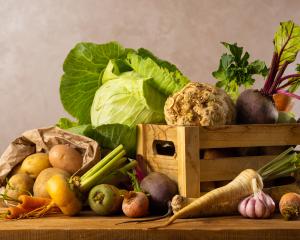Labour Weekend is the time to get cracking in the vege garden but you need not hurry to sow parsnips, says Gillian Vine.
In one of my old garden diaries, I’ve recorded sowing parsnips and there’s a subsequent note "failed to germinate".
With hindsight, I can’t blame the seed but myself for putting them in on October 1 in a year when spring temperatures were low until well into November.
Parsnips (Pastinaca sativa) just won’t get started unless the soil is warm, not dropping below about 10degC.
Two other factors have given parsnips the reputation of being tricky to grow.
The first is that, unlike that of cabbages and beans, the seed is quite short-lived, viable for two seasons at most, although it is best bought fresh every season.
If last year’s is to be sown, be heavy-handed to compensate for the expected poor germination rate.
In the event of a minor miracle and a good strike, the seedlings can be thinned.
The second failure factor is that parsnips, like other root vegetables, need even moisture from the time the flat seed is sown until harvesting, something that is best left until the frosts have come and some of the starches in the roots are converted into sugars.
Most gardeners would not want to imitate Englishman Joe Atherton, who holds the world record for the longest parsnip, a 5.607m monster.
Nonetheless, his effort is a reminder that, even with the shorter varieties like Guernsey, the roots are quite long — 45cm or more — and need well-worked soil with no stones to interrupt downward progress.
Seedlings take about three weeks to pop up and thinning can start as soon as the plants are big enough to handle.
More thinning may be needed later so the parsnips have room to grow straight with plump bodies.
The end result should be about 10cm between plants.
If this sounds like a chore, seed tapes of Javelin and Hollow Crown are available, cutting the need to thin.
From seed-sowing to harvesting takes four to six months and some gardeners trim the leaves to stop them shading adjacent crops.
It pays to be somewhat cautious when trimming because the juice in the stems and leaves of parsnips can cause a skin rash or blisters.
Interestingly, this occurs only if the skin is exposed to sunlight after being "juiced", a photochemical burn in other words, so wearing gardening gloves and long-sleeved tops and trousers is a sensible precaution.
Have no concerns about putting trimmings in the compost bin, as there is no risk once they rot.
Like carrots, to which they are related, parsnips have a two-year life cycle which is why fine roots start growing in spring on any of last season’s crop left in the ground.
Parsnips probably originated around the Mediterranean and spread across Europe, so that by the 1500s the English were growing it as their main winter vegetable, potatoes having yet to make an appearance.
Some of the parsnips now available could be termed heritage types, as they have been around for decades.
Hollow Crown dates back to the 1820s, as does French heirloom Guernsey.
Frustratingly, most early advertisements for parsnip seed in New Zealand does not give varieties.
Two exceptions were Large Jersey, advertised in the Lyttelton Times in 1854 and Hollow Crowned Jersey (Evening Post, 1866).
It is possible these were the same, as in 1900 the gardening writer of Milton’s Bruce Herald noted that only one parsnip variety was available in this country.
The main varieties on the market now are Hollow Crown, Javelin, Supersnip, VIP, Guernsey and Yatesnip.
Compared with the couple of dozen carrot choices, that may not sound impressive but it gives the keen gardener enough choices to ensure plenty of roast parsnips or bowls of parsnip soup next winter.

















